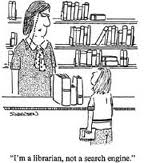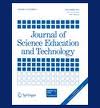 Like the caption here suggests, technology is redefining how we access information. This is by now old news. Five years ago I learned how to access information through a university library’s electronic database system, including how to find out where some of the most obscure European classical music pieces reside – something that required lengthy and labor intensive search criteria. This is old news too, even though it was new for me at the time. What is new, or at least something new ubiquitously, is that the search engine is a daily fact of life for almost everyone I know, and more importantly, we all use it differently.
Like the caption here suggests, technology is redefining how we access information. This is by now old news. Five years ago I learned how to access information through a university library’s electronic database system, including how to find out where some of the most obscure European classical music pieces reside – something that required lengthy and labor intensive search criteria. This is old news too, even though it was new for me at the time. What is new, or at least something new ubiquitously, is that the search engine is a daily fact of life for almost everyone I know, and more importantly, we all use it differently.
What isn’t new, for the most part, is the way students are being taught in institutional settings – by teacher dominated homogenous groups. Kurt Squire and Mingfong Jan highlight how today’s students perceive their world: “what is ‘true’ is what works in experience or is the consensus of a community, as opposed to appeals to authority—what the teacher dictates as correct.” (6).
Students engage in social media, games, chats, tweets, etc. constantly, that is, whenever their not in a classroom, but then again… While knowing how to use electronic databases is extremely valuable, it meant little to me until I had to put it to extensive use later on in my graduate career. If educating students was only about teaching them alternative ways to access information, then we need not ponder any longer something students do very well on their own. But if we, as educators, want to engage students on the level of what each and every student needs, then we must embrace ideas that allow students to choose their learning outcomes.
I would like to begin this week’s reflection on UCSB’s ED 256 course readings with some ideas from Sasha Barab and Chris Dede’s article located in a 2007 special issue of the Journal of Science Education and Technology. Instead of relaying scientific facts

through lecturing, Barab and Dede point out that “knowledge and skills in science should be situated as an inquiry process…” (1). The authors relate that new technologies and designs can be used for students to work toward the investigation of science rather than acquiring scientific knowledge as dictated by teachers. One way to accomplish this task is to use the creative power of computer gaming to enhance student learning. Barab and Dede note that a “game-based scenario” can reshape the learning environment.
A collaborative, social, and engaging game-type platform is quite an opposite approach from a standard cultural climate where teachers and print media control how learning takes place. Educators are quickly learning that students are connected to technology outside the classroom on a regular basis. This connectivity is vibrant and engaging and will obviously be increasing with succeeding generations. It is imperative that educators and school systems learn how to harness the use of technology, not as another social platform or entertainment center, but as a space where the tools of engagement allow learning to take place through collaborative inquiry.
The entries in this journal issue are studies that do exactly this kind of work. By highlighting some of those ideas below, I hope to make connections between how these emerging technologies and concepts might be useful in other fields of inquiry. Specifically, how might a gaming platform similar to those described in these articles be used to engage students in role-playing activities about music and popular culture?
In Neulight et al, students created avatars in a “multi-user virtual environment (MUVE)” who were susceptible to a virtual epidemic (48). This simulated scientific study tracked the progress of students perceptions of infectious diseases and included a data analysis of how the students came to conclusions about the spread of disease.
While the data was fascinating and important, I found the premise of the game more interesting. Students were able to chat with each other about what was happening with their illnesses and the illness of others. They could also create different hypothetical scenarios and outcomes by changing parameters of the game. Importantly, the authors relate how an increasing level of what they term “immersiveness” tended to heighten the emotional connection with the simulated game. Immersiveness is akin to a “feeling of presence in the simulation and the integration of the simulation into the classroom curriculum” (48). Generally speaking, when students have the ability to manipulate their personal learning environment, the level of engagement is certainly much higher than a conventional classroom setting.
Squire and Jan introduce five “core features pertinent to designing games for learning” that are already present in games involving science education (8). These five features are explained using a sociocultural viewpoint. (1) The “games ask students to inhabit roles…” where “game designers use differentiated roles to encourage (and indeed require) collaboration across groups; (2) Activity is organized around challenges” that “employ multiple challenge/reward structures designed to support engagement, collaboration, and learning; (3) “Games offer opportunities to tie goals to particular places, particularly, sites of contested spaces; (4) Digital games allow for embedding authentic resources and tools that are used within the context of game play; (5) Recent work on gaming has illuminated the fundamentally social nature of game play, suggesting that frequently the game community, not the game, is a productive unit of analysis for educators” (8-9, italics in original).
The preceding ideas about immersiveness and simulation, along with the five core features of game design for learning, offer a platform for designing interactive and collaborative ways of learning. In Squire and Jan’s hypothetical “virtual investigation” of Ivan Illyich, (see Squire and Jan 2007), students take on differing roles in order to help solve Illyich’s mysterious death. What is important to me is the level of role-playing and collaboration that must take place in order for the mystery to be pieced together effectively. This is the ultimate goal, not what actually happened to Illyich.
I believe all of these principles and ideas could be used to engage students in learning about all sorts of subjects – the ‘hard’ and ‘soft’ sciences, language, history, anthropology, art, music, etc. – in virtually any setting.
In having students choose a role (and eventually choosing another or trying on different roles), and interacting with other roles chosen by other students, each and every student can benefit in some way. Whether introverted, extroverted, complacent, gregarious (insert adjective), each student can try differing roles. In popular music studies these roles might include a lead singer or guitarist of a band, a promoter, a graphic artist who designs band logos, a music industry lawyer, a band manager, agent, fans, or many other roles related to the music industry.
From an ethnomusicological perspective, the social interaction of these roles integrated with authentic resources and tools could create a colorful and engaging simulation of how people make music. At the same time, students would have the opportunity to engage in social theory on a practical level.
How would this facilitate the learning of social theory you may ask? I will consider a somewhat extreme example that might be best suited for high school or college aged students: If you are a writer of a fanzine for punk music and love to don safety pins in your ear lobes, you are initially a part of a subculture that is making a bold statement juxtaposed to a dominant mainstream society that sees this as subversive. When a pop-up chat between you and the teacher in your local school has that teacher asking you to stop distributing news about the crazy antics of your favorite punk lead singer, you may get a simulated sense of what it feels like to be marginalized, or at best, a simulated version of how authority figures attempt to control what they perceive as a misinformed group of people. But then again, you can reverse the role next time, and as the teacher, join the fanzine writer at the next performance.
SOURCES
Barab, S., and Dede, C. 2007. “Games and Immersive Participatory Simulations for Science Education: An Emerging Type of Curricula.” Journal of Science Education and Technology. 16, no.1. 1-3.
Neulight, N., Kafai, Y., Kao, L., Foley, B., Galas, C. 2007. “Children’s Participation in a Virtual Epidemic in the Science Classroom: Making Connections to Natural Infectious Diseases.” Journal of Science Education and Technology. 16, no.1. 47-59.
Squire, K., & Jan, M. 2007. “Mad City Mystery: Developing Scientific Argumentation Skills with a Place-based Augmented Reality Game on Handheld Computers.” Journal of Science Education and Technology. 16, no 1. 5-29.

